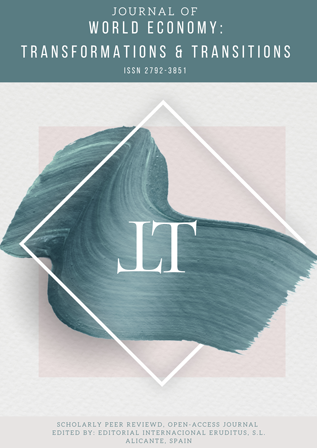Labour Demand Analysis in the ICT Sector: EU Countries and Türkiye
DOI:
https://doi.org/10.52459/jowett36240323Keywords:
ICT, Marshall Third Rule, Labour demand, EU, Türkiye, Panel data analysis, Fixed effects model, Least squares dummy variablesAbstract
This paper is dedicated to specific research on the information and communications technologies (ICT) sector, where the variables determine labour demand in the European Union (EU) and Türkiye. The research aims to clarify the relationships between employment-generating firm growth that represents labour demand and the independent variables identified by the authors. For this purpose, our method analyses the factors affecting labour demand econometrically. In the study, a panel data set of 22 countries, including 21 EU countries and Türkiye, is used for the period of 2014-2019. The results show that there is a positive and significant relationship between employment in the ICT sector and real gross domestic product (GDP) per capita and frequency of internet use. In addition, the results show that the relationship between employment and wage level in the ICT sector is negative and significant. According to the results obtained from the Fixed Effects (FE) model, the elasticity coefficients of the independent variables in the model present for wages (1.53), GDP per capita (3.27) and frequency of internet use (1.60). Finally, we have discussed the results estimated by the Shadow Variable Least Squares (LSDV) method to measure the impact of each country on the overall variability in employment level. As a result of the study, when labour demand is associated with firm employment increase, the countries in the target geography where a significant and positive relationship was found are Belgium, Bulgaria, Croatia, Czechia, Estonia, Finland, Germany, Hungary, Italy, Latvia, Netherlands, Poland, Portugal, Romania, Slovakia, Spain, Sweden, and Türkiye.
CITE THIS PAPER:
Şişman, Deniz; Şişman, Mehmet; Yanık, Ahmet H. (2023). Labour Demand Analysis in the ICT Sector: EU Countries and Türkiye. Journal of World Economy: Transformations & Transitions (JOWETT) 3(06):24. DOI: https://doi.org/10.52459/jowett36240323
Metrics
References
Arellano, M. (1987). Computing robust standard errors for within-groups estimators. Oxford Bulletin of Economics and Statistics, 49(4), 431–434. DOI: https://doi.org/10.1111/j.1468-0084.1987.mp49004006.x
Baltagi, B. H., & Wu, P. X. (1999). UNEQUALLY SPACED PANEL DATA REGRESSIONS WITH AR(1) DISTURBANCES. Econometric Theory, 15(6), 814–823. DOI: https://doi.org/10.1017/S0266466699156020
Bhargava, A., Franzini, L., & Narendranathan, W. (1982). Serial Correlation and the Fixed Effects Model. The Review of Economic Studies, 49(4), 533–549. DOI: https://doi.org/10.2307/2297285
Brown, M. B., & Forsythe, A. B. (1974). Robust Tests for the Equality of Variances. Journal of the American Statistical Association, 69(346), 364–367. DOI: https://doi.org/10.1080/01621459.1974.10482955
De Hoyos, R. E., & Sarafidis, V. (2006). Testing for Cross-Sectional Dependence in Panel-Data Models. The Stata Journal: Promoting Communications on Statistics and Stata, 6(4), 482–496. DOI: https://doi.org/10.1177/1536867X0600600403
Eicker, F. (1967). Limit theorems for regressions with unequal and dependent errors. 1(1), 59–82.
Eurostat. (2023a). High growth enterprises (growth by 10% or more) and related employment by NACE Rev. 2 [Data Set].
Eurostat. (2023b). Individuals—Frequency of internet use (Individuals - Frequency of Internet Use) [Data set].
Eurostat. (2023c). Labour cost index, nominal value—Quarterly data [Data set].
Eurostat. (2023d). Real GDP per capita [Data set].
Friedman, M. (1937). The Use of Ranks to Avoid the Assumption of Normality Implicit in the Analysis of Variance. Journal of the American Statistical Association, 32(200), 675–701. DOI: https://doi.org/10.1080/01621459.1937.10503522
Froot, K. A. (1989). Consistent covariance matrix estimation with cross-sectional dependence and heteroskedasticity in financial data. Journal of Financial and Quantitative Analysis, 24(3), 333–355.
Greene, W. (2000). Econometric Analysis (Prentice-Hall, Inc., Upper Saddle River (NJ)).
Greene, W. H. (2003). Econometric analysis (5th ed). Prentice Hall.
Griliches, Z., Hall, B. H., & Hausman, J. A. (1978). Missing data and self-selection in large panels. 137–176. DOI: https://doi.org/10.2307/20075289
Hoffman, S. D. (2009). Revisiting Marshall’s Third Law: Why Does Labour’s Share Interact with the Elasticity of Substitution to Decrease the Elasticity of Labour Demand? Journal of Economic Education, 40(4), 437–445.
Huber, P. J. (1967). The behavior of maximum likelihood estimates under nonstandard conditions. Proceedings of the Fifth Berkeley Symposium on Mathematical Statistics and Probability, Volume 1: Statistics, 5.1, 221–234.
İmamoğlu, Z., & Soybilgen, B. (2014). Politika notu: Türkiye’de bilişim teknolojisi ve ekonomi. Betam.
Kennan, J. (1998). The Hicks-Marshall rules of derived demand: An expository note. University of Wisconsin, Madison.
Levene, H. (1960). Robust tests for equality of variances. Contributions to Probability and Statistics, 278–292.
Perloff, j. M. (2014). Mikro Ekonomi (M. Şişman, D. Şişman, S. Yavuz, & A. Çakmak, Trans.; 8th edition). Bilim Teknik Yayınevi. ISBN: 9786053650324.
Pesaran, H. (2004). General diagnostic tests for cross section dependence in panels (working paper in Economics No. 0435). USA: University of Cambridge.
Rogers, W. (1993). Regression standard errors in clustered samples. Stata Technical Bulletin, 13, 19–23.
Şişman, D., & Şişman, M. (2018). An Analysis on Information Technologies (ICT) in EU Transition Economies: Application of Marshall’s Third Law. GLOBAL ECONOMY ECONOMIC CRISES & RECESSIONS, 99.
White, H. (1980). A heteroskedasticity-consistent covariance matrix estimator and a direct test for heteroskedasticity. Econometrica: Journal of the Econometric Society, 817–838. DOI: https://doi.org/10.2307/1912934
Yerdelen Tatoğlu, F. (2013). Panel veri ekonometrisi: Stata uygulamalı (4th edition). Beta Yayınları. ISBN: 9786052426913
Downloads
Published
Issue
Section
License
Copyright (c) 2023 Deniz ŞIŞMAN , Mehmet ŞIŞMAN, Ahmet Hamdi YANIK

This work is licensed under a Creative Commons Attribution 4.0 International License.







